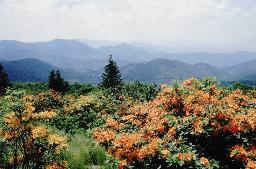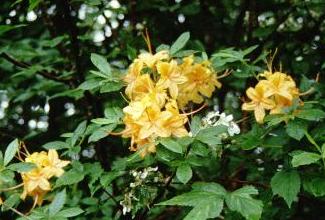


Next: Favorite Locations
Up: Identifying the Natives
Previous: The Pink Group
 The remaining five species belong to the "Orange Group" although their flowers are not always orange but can range from shades of clear yellow through gold, to deepest red. The early blooming
R. austrinum is the only fragrant native of this group and its flowers are typically gold or yellow with a long red flower tube. There are some excellent forms of austrinum already on the market including "Lisa's Gold" and "Millie Mac".
The remaining five species belong to the "Orange Group" although their flowers are not always orange but can range from shades of clear yellow through gold, to deepest red. The early blooming
R. austrinum is the only fragrant native of this group and its flowers are typically gold or yellow with a long red flower tube. There are some excellent forms of austrinum already on the market including "Lisa's Gold" and "Millie Mac".
R. flammeum (formerly R. speciosum) also has long flower tubes. It is early blooming too, but the flowers are usually orange or red with a prominent blotch and there is no fragrance. The clone "Hazel Hamilton" is a nice yellow form of flammeum, but is reportedly difficult to propagate and has limited distribution in the trade.
R. prunifolium is easily distinguished from the first two because of its very late season of bloom. Prunifolium is typically coral orange to deep red with a long flower tube and begins its floral display at the end of July or August. There are excellent stands of prunifolium in Georgia's Providence Canyon as well as extensive plantings at Callaway Gardens.
The other two species in the Orange Group,
R. calendulaceum
and
R. cumberlandense
(formerly known as R. bakeri), have shorter flower tubes than the first three species mentioned in this group, but are difficult to distinguish between one another. Genetically, calendulaceum is actually a tetraploid having twice the number of chromosomes as cumberlandense or any other native azalea species. However one cannot tell this fact from casual inspection. The flowers of calendulaceum are usually larger than cumberlandense though, and it usually blooms before the leaves have fully expanded. With cumberlandense, next year's flower buds are often forming as the current season's blooms open.
There are superior forms of cumberlandense already in the trade, including "Camp's Red" that was introduced by the National Arboretum. Members of the Middle Atlantic Chapter ARS Species Study Group would often travel down the Cherohala Skyway from North Carolina into Tennessee to see R. cumberlandense in bloom. In June of 2000, we were particularly disappointed to find that someone had recently dug up a favorite deep red form of cumberlandense from its site along the roadside. Theft from the wild is a very serious problem with native azaleas as well as many other wildflowers.
 R. calendulaceum is widespread and quite variable. There are many excellent forms being introduced into the trade, such as "Cherokee" or "Kelsey's Flame." Travelers are amazed at the beautiful forms growing right along the roadside, but I wonder what variation exists throughout its natural realm. At a recently opened trail to
Hooper Bald, our Species Study Group has documented some of the largest flowered forms of calendulaceum that we have ever seen. One superior form we call "Hooper Copper" because of its coppery-orange flower color. The flowers of this selection are in excess of 3 inches in diameter, huge for representatives of the species. The flower edges on "Hooper Copper" are plain without any frill or ruffling. There are some nice gold, orange, and orange-red forms at Hooper Bald, but we have not noticed any clear yellows. Unfortunately, these plants are becoming overgrown by trees and shrubs, so unless proactive measures are taken to give them some growing room, they could easily be lost. Another concern is that feral pigs on Hooper Bald are also causing significant damage to the environment by burrowing for roots and grubs.
R. calendulaceum is widespread and quite variable. There are many excellent forms being introduced into the trade, such as "Cherokee" or "Kelsey's Flame." Travelers are amazed at the beautiful forms growing right along the roadside, but I wonder what variation exists throughout its natural realm. At a recently opened trail to
Hooper Bald, our Species Study Group has documented some of the largest flowered forms of calendulaceum that we have ever seen. One superior form we call "Hooper Copper" because of its coppery-orange flower color. The flowers of this selection are in excess of 3 inches in diameter, huge for representatives of the species. The flower edges on "Hooper Copper" are plain without any frill or ruffling. There are some nice gold, orange, and orange-red forms at Hooper Bald, but we have not noticed any clear yellows. Unfortunately, these plants are becoming overgrown by trees and shrubs, so unless proactive measures are taken to give them some growing room, they could easily be lost. Another concern is that feral pigs on Hooper Bald are also causing significant damage to the environment by burrowing for roots and grubs.



Next: Favorite Locations
Up: Identifying the Natives
Previous: The Pink Group
Donald W. Hyatt
2001-06-26
 The remaining five species belong to the "Orange Group" although their flowers are not always orange but can range from shades of clear yellow through gold, to deepest red. The early blooming
R. austrinum is the only fragrant native of this group and its flowers are typically gold or yellow with a long red flower tube. There are some excellent forms of austrinum already on the market including "Lisa's Gold" and "Millie Mac".
The remaining five species belong to the "Orange Group" although their flowers are not always orange but can range from shades of clear yellow through gold, to deepest red. The early blooming
R. austrinum is the only fragrant native of this group and its flowers are typically gold or yellow with a long red flower tube. There are some excellent forms of austrinum already on the market including "Lisa's Gold" and "Millie Mac".
 R. calendulaceum is widespread and quite variable. There are many excellent forms being introduced into the trade, such as "Cherokee" or "Kelsey's Flame." Travelers are amazed at the beautiful forms growing right along the roadside, but I wonder what variation exists throughout its natural realm. At a recently opened trail to
R. calendulaceum is widespread and quite variable. There are many excellent forms being introduced into the trade, such as "Cherokee" or "Kelsey's Flame." Travelers are amazed at the beautiful forms growing right along the roadside, but I wonder what variation exists throughout its natural realm. At a recently opened trail to